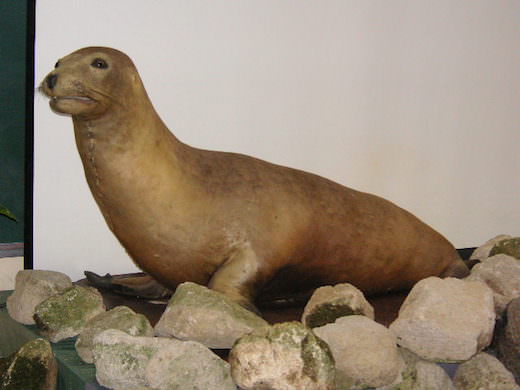Japanese Sea Lion

Extinct 1974
Japanese Sea Lion was considered to be a subspecies of Californian Sea lion but in 2003 it was proven that this aquatic mammal was a unique species of sea lion. It is also known as a Black Sea Lion. It was the member of eared seal family together with fur seals and other sea Lions which is different than true seals as they have the small eternal earflaps and hind flippers that can be turned to face forwards. This gives a great sense of mobility to eared seal the same feature that the Japanese Sea Lion possessed. Not much is known about the appearance of sea lions but its other name the Black sea lion shows us that adult males had a darker color while females had lighter color similar to brown. We know this as the development of photography helped us to see these magnificent sea creatures at least in pictures. The adult males were at average 2.5 meters in length and weighed from 450 to 560kg, adult females were around 1.4 meters so they were a lot smaller than the male specimen.in length while a four month old pup was 65 cm long and 9kg in weight. Japanese Sea Lion’s diet was consisted of fish that it could find around its habitat.
Habitat
Even though the animal is called Japanese Sea Lion it extended further from the maritime area of Japan. The range of this specimen was Northwest Pacific mostly Japan, Korea and Russian Kamchatka island. Unlike other sea lions Japanese sea lion liked to be more in the caves a fact that cannot be explained rationally. They had only went to the beach during the mating period and sometimes the mating period took place at the stony beach.
Extinction
This animal did not have any natural enemies except humans who used its meat for food and also its skin and oil. The oil was used to make old lamps, the skin was used to make clothing like shoes and even blankets. The internal organs were used to make various remedies. The whiskers were used to make pipe cleaners. The fishermen had also hunted the Japanese sea lion so they can have more access to fresh water and that they can catch more fish. Another thing that contributed to their extinction is a submarine warfare during the WW2 as it had destroyed their natural habitat.
It is estimated that 30,000 to 50,000 Japanese sea lions existed in the nineteenth century. Japanese fishermen reported that they harvested 3,200 sea lions in the beginning of the 20th century. The population fell to 300 in 1915 while in thirties the number was not even close to fifty. The commercial harvest stopped in 1940s as Japanese sea Lions were at the brink of extinction.
The last known observation of Japanese Sea lion happened in 1951 and it was of fifty to sixty seals which had been seen on the Liancort Rocks (Japanese-Takeshima; Korean –Dokto or Tokdo). Sightings have been reported in 1970s, though none were confirmed and it was declared extinct. The scientific community was glad when they heard that there were sightings of Japanese sea lion in 2003 but in the end those were confirmed to be Californian sea lions. South Korea, Russia and China decided to try to recreate the Japanese Sea lion if that is not possible they planned relocate the Californian Sea Lion to the previous habitat of the Japanese sea lion.